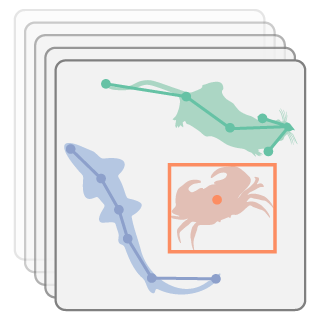Appendix B — Contributing
Thank you for considering contributing to the Animals In Motion project! We welcome contributions in various forms, including bug reports, requests for content improvement, as well as new tutorials or case studies.
B.1 Setting up the development environment
Begin by cloning the repository and navigating to its root directory:
git clone https://github.com/neuroinformatics-unit/course-animals-in-motion.git
cd course-animals-in-motionWe use conda to manage dependencies. First, create a development environment using the environment-dev.yaml file, and activate it:
conda env create -n animals-in-motion-dev -f environment-dev.yaml
conda activate animals-in-motion-devTo enable the pre-commit hooks, run the following command once:
pre-commit installThis is a Quarto book project, with its source code located in the book/ directory. We refer you to the Quarto documentation for more information on how books are structured and configured.
To render/preview the book locally, you’ll need the Quarto CLI installed, as well as the VSCode Quarto extension
You will also need to make sure that the QUARTO_PYTHON environment variable is set to the path of the python executable in the development conda environment. This guarantees that the Quarto CLI will use the correct Python interpreter when rendering the book.
export QUARTO_PYTHON=$(which python)Then, you can render the book using:
quarto render book
# or if you want to run executable code blocks before rendering to html
quarto render book --executeYou can view the rendered book by opening the book/_book/index.html file in your browser.
B.3 Pre-commit hooks
We use pre-commit to run checks on the codebase before committing.
Current hooks include:
- codespell for catching common spelling mistakes.
- markdownlint for (Quarto) Markdown linting and formatting.
- ruff for code linting and formatting.
These will prevent code from being committed if any of these hooks fail. To run all the hooks before committing:
pre-commit run # for staged files
pre-commit run -a # for all files in the repositoryB.4 Versioning and releasing
We use Calendar Versioning (CalVer) and specifically the YYYY.0M scheme (e.g. 2025.08 for August 2025).
To create a new release, first update the book/index.qmd file. Specifically, add two rows like the following to the “Versions” table:
| `v2025.08` | version used for the inaugural workshop in August 2025 |
| `v2025.08-answers` | same as `v2025.08` but with answers to exercises |You also need to create a new tag in the vYYYY.0M format (e.g. v2025.08) and push it to the repository. Don’t forget the v prefix for the tag name!
For example:
git tag v2025.08
git push origin --tagsB.5 Continuous integration (CI)
The CI workflow is defined in the .github/workflows/build_and_deploy.yaml file and can be triggered by:
- Pushes to the
mainbranch - Pull requests
- Releases, i.e. tags starting with
v(e.g.,v2025.08) - Manual dispatches
The workflow is built using GitHub actions and includes three jobs:
- linting: running the pre-commit hooks;
- build: rendering the Quarto book with and without answers, and uploading the rendered artifacts;
- deploy: deploying the book artifact(s) to the
gh-pagesbranch (only for pushes to themainbranch and releases).
Each release version is deployed to a folder in the gh-pages branch, with the same name as the release tag (e.g., v2025.08). This is accompanied by a vYYYY.0M-answers folder containing a version of the book with answers to exercises (e.g. v2025.08-answers).
There’s also a special folder called dev that is deployed for pushes to the main branch. This folder always includes the answers to exercises.
